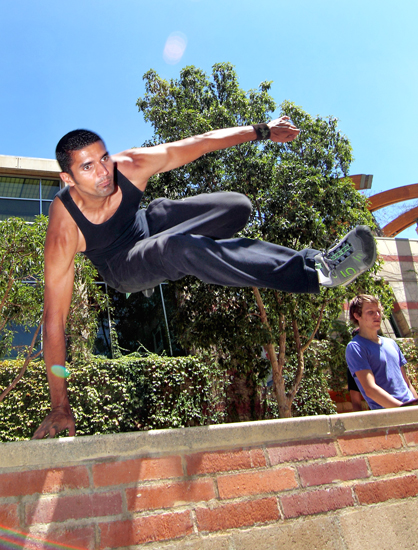When you think of a job, jumping off the 30-foot ledge behind Ackerman Union and doing a front-flip tuck ‘n’ roll probably aren’t the first things to come to mind. But for Josh Yadon, a 22-year-old from Dana Point, such a mischievous routine takes precedence over his occupation as a combat medic for the Marine Corps.
“Even though I don’t get paid for this, this is my real job,” Yadon said, moments after completing a front flip while recording himself with a handheld camera.
Yadon was one of 60 people attending Saturday’s Massive West Coast Jam at UCLA, a showcase of parkour talent featuring local groups including Parkour Los Angeles and Parkour California. A sport that combines the intensity of martial arts, the elegance of gymnastics with a whole lot of running, jumping and Matrix-like maneuvers, parkour emerged in the mainstream only recently with the help of YouTube videos and movies.
But Mohammad Shaibi, a 25-year-old from Rancho Cucamonga, doesn’t practice parkour simply to impress audiences with his corkscrew flips. Parkour provides him with a feeling that other extreme sports such as skateboarding, BMX and snowboarding don’t: a sense of being alive. It’s the ability to define himself through his movements, to be in total control.
The art of parkour can only be described as raw and organic. There is no competition, only you and the world. Many of the traceurs and traceuses, or men and women who practice parkour, hurdling over platforms and running up walls would prefer to call UCLA one of their “playgrounds.” The brick walls are perfect to climb, the hand railings are ideally angled for swift slides, and open areas on campus allow “flow” ““ the combination of movements to clear various obstacles.
But parkour is more than just an extreme activity that entails tackle spin-ups, front flips and jumps that would make any mother nervous. For many, such as Jeremy Lee, parkour is a way of life.
“It changes how you see the world,” said Lee, a 2008 materials science graduate from UCLA. “Physical obstacles, emotional obstacles … nothing seems insurmountable.”
For Lee, discovering parkour may have had a greater impact than for others. Having graduated in the midst of a recession, he had difficulty finding a job as well as a tangible purpose. But it was through parkour that Lee was able to find a new path and a venue for self-expression.
“Before I started parkour, every moment in my life I was following a track that had been laid out by teachers, parents, society in general. Now anytime I’m doing parkour, I’m not doing it for anyone else. I’m doing exactly what I want to do. Every moment is mine,” Lee said.
Although some of the stunts seem life-threatening, safety is the top concern for these men and women. Most who practice parkour train in gyms with foam pads, perfecting their craft before experimenting out in the environment. Every bench, stairway, window panel and wall is a new opportunity and challenge. And yet, nothing is attempted without first a practice session. In fact, many of the minor sprains and bruises were sustained in the practice gym.
Brooke Hunter, a 24-year-old administrative care partner at the Ronald Reagan UCLA Medical Center and one of the few traceuses who made an appearance for the Saturday gathering, understands the misconceptions people may have about her sport.
“Getting over the fear of hurting yourself … the psychological aspect is the biggest thing,” Hunter said. “To be a real human being, to be strong, to be helpful, to be honest.”
This aspect also intrigued Anton Malyshev, a UCLA graduate student in mathematics.
“Part of the appeal is getting to know my limits physically and mentally,” Malyshev said. “It is a competition with myself.”
Behind every dive, cartwheel, handstand and balancing act lies a search for meaning. Some may view these gravity-defying daredevils as misfits. Others may see them as crazy. But for Cliff Kravit, the founder of PKCali, the purpose cannot be any clearer than to “better ourselves and to live our lives better.”
There are no rules.
There are no restrictions.
Traceurs and traceuses find it difficult to describe the feeling of moving through the air, of letting their bodies go. Some, like Yadon, described the sensation as a moment of complete nothingness: no worries, no problems and no pain, but a release in which nothing mattered.
When asked for his opinion, Shaibi offered only a single word: freedom.
